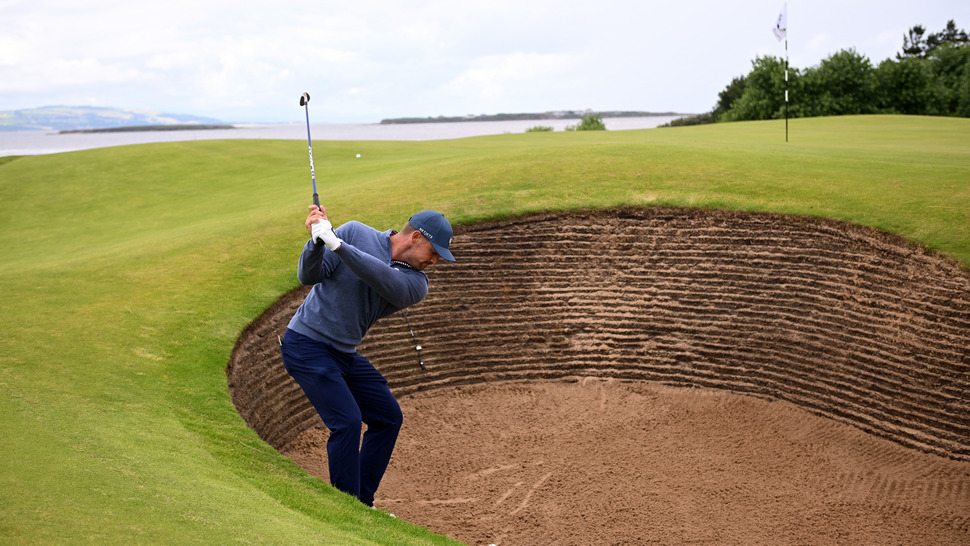Hoylake, England. Clifford Roberts, the long-time Masters major domo, was famous in saying Augusta National doesn’t make change — it only adds improvements.
The 151st Open Championship this week at Royal Liverpool will bring to the forefront a “new” hole that could very well decide which man is able to hoist the famed Claret Jug when play concludes.
The 13-time site for golf’s oldest major event opted to eliminate the former par-3 15th and bring to life a new par-3 that will play in the range of 136 yards. The hole is the brainchild of Mackenzie & Ebert, the architectural firm the club engaged to update the famed layout with The Open in mind.
The penultimate hole is positioned by going in the reverse direction from which the former 15th traversed. The 17th plays to an elevated target and offers an infinity green that brings into view the nearby Dee Estuary and Irish Sea.
The green features closely mown areas around the perimeter of the putting surface and the approach must be played with the utmost precision otherwise balls can easily run off and find a variety of precarious positions from which to recover.
Two bunkers flank the landing area and balls finding these deep pits will be hard-pressed to recover and leave unscathed.
Gareth Williams from Nick Faldo design has seen the hole up close and was asked to weigh in with his comments on how impactful “Little Eye” will be in deciding this year’s “champion golfer of the year.”

***
Gareth Williams
Background
Trained as a Landscape Architect and been a core member of the Faldo Design team since 2006.
Born out of a passion for the natural landscape, sustainability in golf course development strongly influences his approach to design featuring a passionate advocacy of different forms of the game, including par-3 golf and multifunctional facilities. Williams champions progressive designs and golf experiences.
Projects on which he has worked for Faldo Design include: Lough Erne, Ireland; Elea Estate, Cyprus; Vattanac Golf Resort, Cambodia; Chart Hills Short Course, UK.
Williams is also a member of the European Institute of Golf Course Architects (EIGCA) since 2017.
***
How much better is the new hole versus the hole it replaced?
They are completely different holes and each had or has its own unique aesthetic and strategic qualities.
But for its inherent drama as the penultimate hole of an Open course, the new hole delivers exactly what Royal Liverpool Golf Club and the R&A will have wanted.
For the players it will demand precision under pressure and be a nagging threat for the entire round; but for spectators and the TV audience it will deliver a dramatic, stadium-like climax unlike almost any other hole on the Open Championship rota.
Is precision shotmaking finding a rebirth?
Advances in equipment technology over the last 25 years have seen much improved accuracy and length of tee shots, particularly by professionals, and a consequence of that has been shorter approach shots from the fairway on longer holes.
The trend of increasingly long championship par-3 holes was, in part, a reaction to force players to still hit long- and mid-irons, and so in that I’d argue precision shotmaking has always been a requirement.
I wouldn’t necessarily agree that short par-3s ever became unfashionable, with Troon’s 8th and Pebble Beach’s 7th being amongst the most fabled in major championship golf.
However, with lengthening applying as much to par-4s and -5s in recent years, I like to think short par-3s have come back into fashion again. Why? Simply because they are inherently more fun to watch and play – as Hoylake’s new 17th ably demonstrates.

Is Hoylake’s 17th comparable to the 8th at Royal Troon?
On a basic level they are comparable, yes – as short holes played to small putting surfaces and surrounded by swales, mounds, bunkers and long grasses they both have fear factor.
And they also both seemingly offer the possibility of a hole in one. Perhaps their most common factor is the wind, which is constant in its unpredictability and direction and shouldn’t be underestimated.
However, the inherent nature of golf, its landscapes and the natural elements means that they are entirely different holes. Played from a raised tee, the Postage Stamp at Troon is all out in front of the player, a long thin green sat into a dune and surrounded by treacherous bunkers.
In contrast, Hoylake’s “Little Eye” is played from a low position to a horizon, table-top green that falls away on all sides.

Related: Behind the Architectural Curtain – Royal Liverpool Golf Club Pt.1
What makes short par-3 holes so fascinating to create?
An enforced target from the tee is the essence of a one-shot hole but in contrast to mid-to-long- examples, short par-3s have the ability to toy with a player’s psyche like no other.
By removing the demand for distance, the natural human response is to assume reduced difficulty level and for a designer that reaction is fascinating and worth embracing.
But golf is a difficult game even during the best of times, so even the simplest one-shot hole can pose problems.
The joy for me in designing an interesting short par-3 is creating enough deception around the hole that masks the fact that all that is required is one simple shot.
